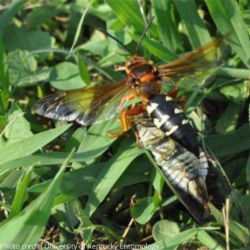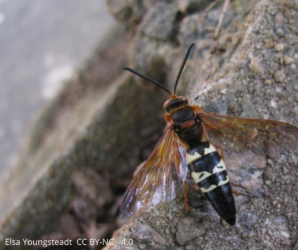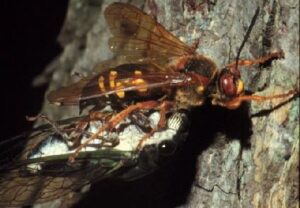By Olivia Belk

If you were not familiar with the distinctive drone of the cicada before, this year’s emergence of the seventeen-year brood probably made you quite well acquainted. It seemed wherever you were, the noise was practically overwhelming, requiring shouts to be heard over the din.
The incessant, undulating hum is woven into the soundtrack of summer, providing a perfect backdrop for many childhood memories. Recently I was walking my dog and heard a buzzing, but it was not the steady drone I was accustomed to – this sound was a higher pitch than normal and almost panicked in nature. I was able to find the source and watched as a large cicada tumbled out of the sky, landing nearby. Intrigued, I approached and my curiosity was rewarded with a fascinating, yet somewhat grisly, sight – grappling the cicada was one of the largest wasps I have ever seen.
The cicada killer wasp, or Sphecius speciosus, is a fascinating species, as well as one that typically causes panic when encountered. This insect can reach a whopping 2 inches long, possessing bright yellow and brown coloration to ward off potential predators. But like many visibly frightening insects, this wasp is generally harmless to humans. According to Justin Schmidt, the inventor of the Schmidt Pain Index for insect stings, cicada killers are the “gentle giants of the wasp world.” Though they may approach and challenge trespassers in their territory by hovering in an intimidating fashion, these formidable insects rarely sting unless directly handled. I know this from experience: they were often found at the golf course where I worked years ago, patrolling the sand traps yet never stinging a soul.

In fact, male cicada killer wasps do not possess stingers at all. The females do, and the purpose of the stinger is directly tied to their name. Females dig subterranean tunnels in which to lay their eggs, creating up to fifteen individual chambers in their lair. This is where things get interesting and somewhat sinister – for each egg, the wasp needs a live cicada. She tracks down a cicada and uses her stinger to inject a fast-acting venom that paralyzes it… permanently. The female drags the cicada back to her lair, lays an egg, and seals the chamber shut. Once the egg hatches, the larva will feed on the live cicada, spin a cocoon, and overwinter until it emerges the following year as a full-grown adult.

These incredible insects can capture over thirty cicadas during their six-week life span, making them vital to keeping cicada populations from exploding. If you’re wondering why we still have massive booms like we did early this year, the answer is that cicada killer wasps do not target the mega broods. Instead, they time their emergence as adults with the annual cicadas that are here every year, which serve as a far more reliable food source.
If you happen upon a cicada killer wasp in the act, they make for an incredible show. As common with many things in nature, using your ears is the best way to track one down – listen for a cicada buzz that is higher pitch and more constant than usual, especially if it is sounding from the ground rather than treetops. Or search for areas of loose, sandy soil where these wasps prefer to dig their tunnels – plant beds, front lawns, playgrounds, and sand traps in golf courses are all excellent contenders.
Finally, if you happen to see golfers wildly swinging their clubs at these ‘menacing wasps’ (a sight I have been delighted by many times), remind them that these insects are entirely harmless, utterly fascinating, and critically valuable predators in our ecosystems.
Be on the lookout for more bug related blogs, videos, speakers, activities, and more during Bernheim’s upcoming Bug-a-Palooza, a week long virtual and in person event happening September 13-18.

